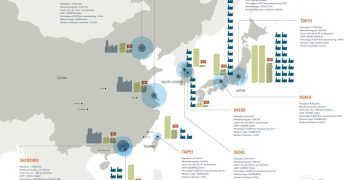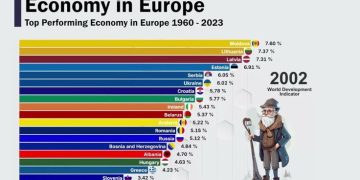Introduction
Financial markets are highly sensitive to changes in policies, whether they involve fiscal measures, monetary policy, trade regulations, or social and environmental policies. As governments and central banks adapt to evolving economic conditions, the policies they implement can significantly affect investor sentiment and market trends. Today’s financial headlines often include key announcements or speculations about upcoming policy shifts that could reshape the global economic landscape. In this article, we will examine which policy changes from today’s news could potentially alter market trajectories and influence investment strategies.
Section 1: Central Bank Interest Rate Decisions and Monetary Policy Shifts
Central bank policies are some of the most significant drivers of market movements, particularly when it comes to interest rates and monetary easing or tightening. Today’s financial headlines reflect ongoing shifts in monetary policy that have the potential to impact markets globally.
Key Policy Changes in Monetary Policy:
- Interest Rate Hikes by the Federal Reserve: The U.S. Federal Reserve has been aggressively raising interest rates to combat inflation, with expectations for continued hikes in the near future. This shift is designed to reduce demand and cool inflation, but it also makes borrowing more expensive. Market Impact: Higher interest rates typically lead to a decrease in equity valuations, especially in high-growth sectors such as technology. This could trigger a rotation away from growth stocks to value stocks or other asset classes like bonds or commodities.
- Tightening by the European Central Bank (ECB): Similarly, the ECB is under pressure to raise interest rates due to inflationary pressures in the Eurozone. The ECB’s actions could have a significant impact on the euro and European equities, particularly those in interest-sensitive industries. Market Impact: As the ECB tightens policy, the euro may strengthen, impacting the competitiveness of European exports. The financial and real estate sectors may benefit from higher interest rates, while sectors reliant on cheap borrowing could suffer.
- Bank of Japan’s Yield Curve Control: The Bank of Japan (BoJ) continues its yield curve control policy, aiming to maintain ultra-low interest rates. However, there are signs that the BoJ may be reevaluating this stance due to inflationary pressures, which could shift soon. Market Impact: A policy shift from the BoJ could significantly affect the Japanese yen and interest-sensitive sectors, such as real estate and utilities. Additionally, Japanese equities could see volatility if the central bank alters its stance on monetary easing.
Overall Market Effects:
- Global Capital Flows: As central banks in major economies adjust interest rates, global capital flows will be influenced. Investors may shift their assets between regions, seeking higher yields, which could lead to currency fluctuations and changes in stock market performance.
- Bond Market Volatility: Rising interest rates generally cause bond prices to fall. With major central banks raising rates, bond markets may see increased volatility, particularly in government and corporate bonds with longer durations.
Section 2: Government Fiscal Policies and Stimulus Measures
Fiscal policy decisions made by governments, including changes to taxation, spending, and stimulus packages, can also have a profound effect on the markets. Today’s financial headlines have highlighted significant shifts in fiscal policies that could change market dynamics.
Key Fiscal Policy Changes:
- U.S. Infrastructure and Spending Plans: The U.S. government’s plans to increase spending on infrastructure and clean energy are advancing, aiming to stimulate economic growth and address long-term structural issues. Market Impact: Increased government spending can create opportunities in sectors like construction, renewable energy, and transportation. Stocks in these sectors may see gains as a result of infrastructure-focused policies. However, concerns about budget deficits or increased taxation may dampen investor sentiment in the long term.
- European Green Transition Funding: The European Union has announced new funding for green projects, with an emphasis on renewable energy, electric vehicles, and sustainable agriculture. This follows earlier commitments to carbon neutrality by 2050. Market Impact: Green and renewable energy sectors are expected to benefit significantly from increased government investments. Investors may look to allocate more capital into sustainable and ESG (Environmental, Social, and Governance) compliant companies, driving up the valuations of green stocks.
- China’s Economic Stimulus Measures: In response to economic slowdown and ongoing trade tensions, China has unveiled several fiscal measures aimed at boosting domestic consumption and stabilizing its real estate market. This includes increased infrastructure investments and potential tax cuts for businesses. Market Impact: A strong fiscal stimulus in China could lead to a rebound in Chinese equities and commodities, particularly in sectors like construction and technology. This may also boost demand for global commodities, including metals and energy products.
Overall Market Effects:
- Sector Rotation: Changes in fiscal policy can lead to a shift in investor preferences toward specific sectors that are expected to benefit. For example, increased infrastructure spending can drive investments in construction, materials, and energy, while green policies may favor renewable energy stocks.
- Currency Markets: Fiscal stimulus measures can influence exchange rates, particularly if they lead to inflationary pressures or change investor sentiment regarding a country’s fiscal health. The U.S. dollar and the euro, for example, could experience volatility as a result of government policy changes.
Section 3: Trade Policies and Global Trade Agreements
Trade policy changes are another crucial factor that can drive market trends. Shifts in trade agreements, tariffs, or sanctions can have significant implications for global supply chains, commodity prices, and international relations.
Key Trade Policy Changes:
- U.S.-China Trade Relations: Trade talks between the U.S. and China remain a focal point. Today’s headlines highlight ongoing discussions about tariffs, technology sharing, and market access, which may lead to changes in trade agreements or the imposition of new tariffs. Market Impact: Escalating trade tensions could lead to market volatility, particularly in sectors reliant on Chinese manufacturing, such as consumer electronics and industrial products. However, resolution of trade issues could improve market sentiment, particularly for companies engaged in international trade.
- Brexit and EU Trade Agreements: As the UK continues to navigate its post-Brexit relationship with the EU and other trading partners, today’s news highlights potential new trade deals. A breakthrough in trade talks could lead to greater market certainty. Market Impact: Positive developments in trade agreements between the UK and its partners could support the British pound and boost UK equities, particularly in sectors like manufacturing and services. On the other hand, ongoing trade disruptions could negatively affect the UK economy and investor confidence.
- Tariff Reductions in Asia: Several countries in Southeast Asia are negotiating tariff reductions to foster trade within the region. These moves are part of a broader effort to strengthen economic cooperation in the Asia-Pacific region. Market Impact: The reduction of trade barriers could benefit industries such as electronics, textiles, and agriculture, which are central to the economies of Southeast Asia. Increased trade and cooperation could boost regional stock markets and attract foreign investment.
Overall Market Effects:
- Commodities and Supply Chains: Changes in trade policies can lead to shifts in the global supply chain, affecting commodity prices, especially in agriculture, energy, and industrial metals. Tariffs and trade restrictions often lead to price volatility, creating opportunities and risks for investors in commodities and raw materials.
- Global Equity Markets: Trade tensions or agreements can influence global equity markets. A trade war, for instance, could hurt global stock prices, while trade deals that improve market access or reduce tariffs could lead to market rallies, particularly in trade-sensitive sectors.

Section 4: Environmental and Regulatory Policy Changes
Environmental and regulatory policies are increasingly playing a crucial role in shaping global economic trends. These policies address sustainability goals, social responsibility, and corporate governance, all of which are becoming key factors in investment decisions.
Key Environmental and Regulatory Policy Changes:
- U.S. Environmental Regulations: The Biden administration has emphasized a shift toward more stringent environmental regulations, focusing on carbon emissions, clean energy, and vehicle emissions standards. Today’s news reports further efforts to reduce reliance on fossil fuels and promote renewable energy initiatives. Market Impact: These regulatory changes are likely to accelerate investments in renewable energy sectors like solar, wind, and electric vehicles. Companies in industries that rely heavily on carbon-intensive practices (such as oil and gas) may face headwinds, leading investors to reconsider their exposure to these sectors.
- EU Carbon Tax: The European Union is advancing its carbon pricing policies, including a new carbon tax aimed at reducing greenhouse gas emissions across the region. This could have major implications for carbon-intensive industries like heavy manufacturing, aviation, and shipping. Market Impact: Companies that are able to adapt to or capitalize on green technologies may see their valuations rise. Conversely, industries with high carbon footprints could see rising costs, impacting profitability and stock prices.
- China’s Environmental Policies: China has introduced new regulations targeting pollution control and carbon neutrality by 2060. Today’s headlines highlight efforts to reduce emissions in the industrial sector and encourage green investments. Market Impact: China’s push toward greener technologies could create opportunities in the renewable energy sector, as well as electric vehicles and energy storage. Companies that fail to comply with new environmental standards may face regulatory fines or operational challenges.
Overall Market Effects:
- Green Investing and ESG Trends: As environmental and regulatory policies tighten, investors will increasingly focus on companies with strong environmental, social, and governance (ESG) practices. This trend is expected to drive growth in sectors related to clean energy, sustainable agriculture, and environmental technology.
- Commodity Prices: Environmental regulations can influence the demand for certain commodities, such as oil, coal, and metals. Rising costs for carbon-intensive industries may prompt shifts in investment strategies, with some investors seeking out greener alternatives or commodities that align with sustainability goals.
Conclusion
Policy changes are among the most influential drivers of market trends, with central bank decisions, fiscal measures, trade agreements, and environmental regulations all having the potential to reshape the global economic landscape. Today’s financial headlines reveal several policy shifts that could significantly impact investor sentiment and market behavior. By staying informed about these policy changes and understanding their potential effects, investors can make more strategic decisions and better navigate the complexities of the global markets.





































